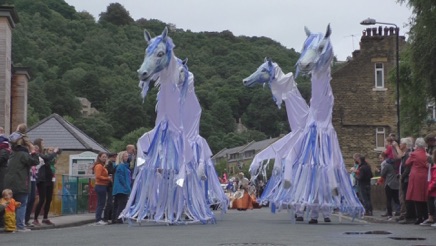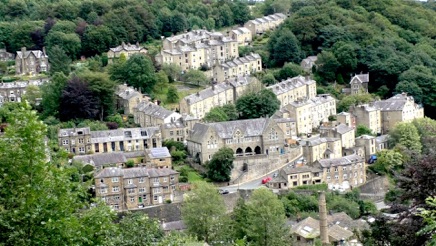Hebden Bridge
CONTACTS & LINKS
Email, Telephone & Address
HOME
Back to the original web page
A Milltown Reborn
Running Time = 110 Minutes
This is the last in the Pathways series, ‘The Valleys of Calderdale.” It traces the town’s growth from a small hamlet around a river crossing, into a bustling mill town, at the centre of the fustian clothing trade, earning it the nickname ‘Trouser Town.’ A post war decline saw many mills and buildings demolished but as the film shows, the conservation movement changed all that.
Calder Civic Trust was formed, followed by Pennine Heritage to protect buildings. David Fletcher relates how Bridge Mill was saved, the Birchcliffe Chapel became a Conference Centre and Nutclough Mill became the home of Calrec Audio Ltd.
Cheap housing and the area’s natural beauty attracted young people from surrounding cities in the so–called “Hippy invasion.” Chris Ratcliffe describes battles to stop the council from demolishing the unique ‘double decker’ houses. Artists of all kinds flocked to the area giving the town its alternative edge.
The whole town becomes a stage for the Summer Arts Festival and the famous Hand Made Parade, there is the Brass Band competition, a Vintage Car Weekend and, rather quirky, a lung-bursting bike trial up the Buttress.
There are several community owned facilities – the new Town Hall and the Picture House which Rebekah Fozard guides us round. We visit the Little Theatre with Dorothy Sutcliffe and go next door to the Trades Club, voted one of the best music venues in the North. Sport is covered with visits to Hebden Cricket Club, White Rose Archers and Aegis Martial Arts. We visit the conserved Victorian Railway Station and wander back via the Canal or Calder Holmes Park.

A tour, starting with the pedestrianised George Square and Bridge Gate gives a ‘piazza’ feeling.The restored Marina has a Visitor Centre, the streets have restaurants and cafes a plenty and independent shops which have bounced back after the flood of Boxing Day 2015. Drone footage shows how the town sits nestled in the heart of the Pennines and old photos bring the stories to life.
So when people say, “That was so Hebden Bridge,” which parts of this town’s complex story can they be referring to?




